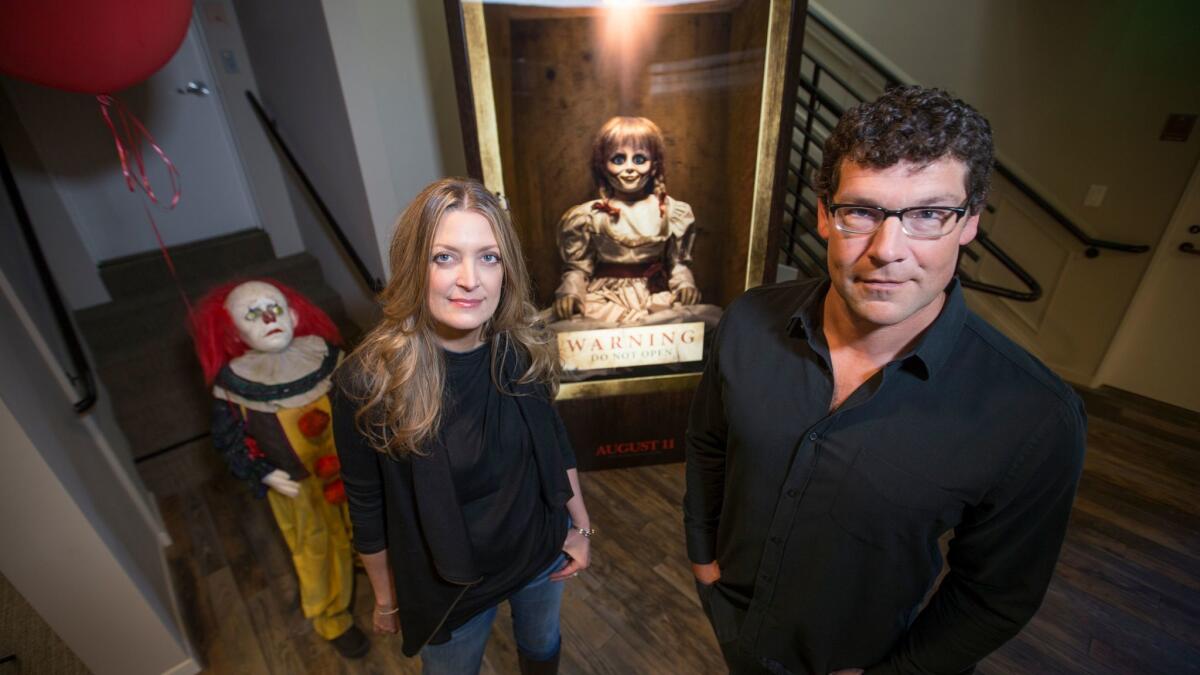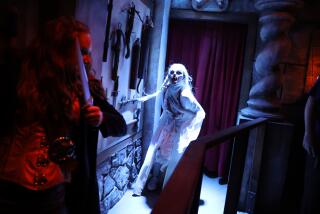With new adaptation of ‘It,’ New Line Cinema hopes to continue horror winning streak

Adapting Stephen King’s “It” for the big screen would’ve been a daunting task for any studio. The sprawling novel about a shape-shifting monster had already spawned a popular TV miniseries and features one of the world’s most recognizable villains, Pennywise the Dancing Clown.
Yet, at the Burbank office of New Line Cinema, the studio behind the upcoming film, there was no hesitation.
“I think I’ve read every single Stephen King book that’s ever been written,” said Carolyn Blackwood, co-head at New Line. “So the opportunity to develop and adapt one of his best-known and best-loved works, that’s a dream.”
New Line, a unit of Warner Bros. with 35 employees, is counting on “It” to continue the studio’s winning streak of horror films following the recent success of “The Conjuring” spinoff “Annabelle: Creation” and last year’s “Lights Out.” The $35-million film, the first of two planned movies, is expected to break September box office records when it debuts this weekend, predicted to gross about $55 million through Sunday.

Bill Skarsgård plays a monster that takes the shape of a clown called Pennywise in the movie remake of “It,” based on the Stephen King novel.
New Line — also known for producing raunchy comedies and the hit “Lord of the Rings” and “Hobbit” trilogies — is capitalizing on one of the few bright spots in the film industry — horror — at a time when theatrical attendance is lagging.
Though horror has often been dismissed as a low-quality cash grab, the genre has been getting more respect in recent years, partly thanks to well-reviewed movies from New Line, such as 2013’s “The Conjuring,” based on demonologists Ed and Lorraine Warren. The latest installment, August’s “Annabelle: Creation,” has grossed $253 million worldwide on a $15-million production budget. The four “Conjuring” movies combined have generated more than $1 billion in ticket sales since 2013, making New Line a consistently reliable money maker for Warner Bros.
“For a genre that is often seen as the ugly stepchild, New Line doesn’t treat it like that,” said “Conjuring” director James Wan.
Horror movies tend to do well because they attract loyal fan bases and lend themselves to big-screen, communal viewing in the confines of a dark theater. As an added bonus, they tend to be cheap to make. The first “Annabelle” grossed $256 million but cost just $6.5 million to produce. And more than ever, horror films represent a safe bet compared to expensive action flicks, so many of which flopped this summer in what has become a feast-or-famine business.
“The New Line films have been a good ballast,” said Toby Emmerich, president and chief content officer of Warner Bros. Pictures Group, who previously ran New Line and remains involved in the studio. “With all the entertainment options that exist, it’s made the theatrical experience a harder target to hit. It has allowed an opportunity for more genre films... to thrive as counterprogramming.”
For a genre that is often seen as the ugly stepchild, New Line doesn’t treat it like that.
— Director James Wan
The horror hot streak is well-timed for New Line’s new co-heads Blackwood and Richard Brener, who were elevated when Emmerich took a larger role overseeing Warner Bros. movies in January. Also key to the strategy are Walter Hamada and Dave Neustadter, who handle the day-to-day production duties on horror films.
Audiences’ tastes for horror have changed rapidly since Brener and Blackwood joined the company in the 1990s and formed a successful, if unique, partnership. They have been working together so long that they often finish each other’s sentences.
“Carolyn is a lawyer and would be on the shortlist for the COO job at any major studio,” Emmerich said. “Her resume, skill set and personality hit a lot of touch points that you need to run an effective company. Richard can speak director, he can speak screenwriter, he can speak producer. He’s someone who has a real gut for filmmaking and storytelling.”
New Line, which made its name as the home of “A Nightmare on Elm Street,” has had to evolve with changing tastes and rising competition. Jason Blum’s Blumhouse Productions has become famous for low-budget horror, including this year’s phenomenon “Get Out” from Universal Pictures.
New Line’s approach to horror has adapted over the years. The films typically feature relatable characters and family themes in scary-movie settings, in contrast to the disposable victims of earlier classic slasher films. That helps broaden the appeal of horror beyond just devotees.
2017 fall movie preview: ‘It,’ ‘Battle of the Sexes,’ ‘Thor: Ragnarok’ and more »
“With ‘The Conjuring’ and now ‘It,’ you have these characters and families that you fall in love with,” Brener said. “You get the added fear of hoping they’re safe as opposed to some other movies where you can’t wait to see how they die.”
It’s led to some risky bets on new ideas and filmmakers. “Lights Out” was based on a viral video by Swedish director David F. Sandberg, who went on to direct “Annabelle: Creation” for the studio and is now working on the DC film “Shazam.” Blackwood recently got New Line into the business of making microbudget horror movies starting with “Annabelle,” based on the demonic doll that was a highlight of the first “Conjuring.”
“That was one of the very pivotal moments for us in creating that genre strategy,” Blackwood said. “Having the flexibility to be able to try stuff out and succeeding at it has been energizing.”
“It” represented a much bigger risk. Director Cary Fukunaga, who’d written a script for “It,” left the project in 2015 over creative disagreements with the studio.
New Line then took the film to Andy Muschietti, whom the studio had courted for various movies since his Universal hit “Mama.” Muschietti, pitching his vision for New Line executives, brought in a marked-up script and doodles, saying he wanted to stay true to King’s book in the visuals and tone.
He also saved some characters from the scrap pile. In an earlier draft, he said, characters Richie Tozier and Stanley Uris were merged into a composite kid. The characters were saved.
New Line had to walk a tightrope of making sure it created something that wouldn’t seem derivative, while also not alienating fans of previous versions. Fans of the novel or the Tim Curry miniseries made up at least 20% of the audience for the studio’s test screenings for “It,” and those were the audience members who had the most positive reactions, Brener said.
Warner has waged an ambitious marketing campaign for the movie, which was filmed in Ontario, Canada, and stars Bill Skarsgård as the clown. To promote “It,” the studio created a re-creation of the film’s haunted Neibolt house on the corner of Hollywood Boulevard and Vine Street so groups of fans could walk through and post pictures to social media.
New Line executives say they pride themselves on being frugal, even with bigger-budget movies. Blackwood, for example, was in charge of getting the Peter Jackson “Hobbit” films made back-to-back in New Zealand. For the upcoming Dwayne Johnson movie “Rampage,” based on the Midway video game, the studio created the visual effects before filming, a technique that cuts down on expensive shoot days.
“We believe that whatever we make, we want to make the most fiscally responsible version of that movie while supporting the creative vision, too,” Blackwood said. “We think it’s an important part of our approach, especially in today’s tough marketplace.”
ALSO:
Bill Skarsgard’s Pennywise from ‘It’ looks to leap off the page and into the psyche of viewers
John Carpenter, Stephen King and more horror world greats react to the death of Tobe Hooper
J.J. Abrams and Hulu will explore Stephen King’s ‘Castle Rock’
More to Read
Inside the business of entertainment
The Wide Shot brings you news, analysis and insights on everything from streaming wars to production — and what it all means for the future.
You may occasionally receive promotional content from the Los Angeles Times.











